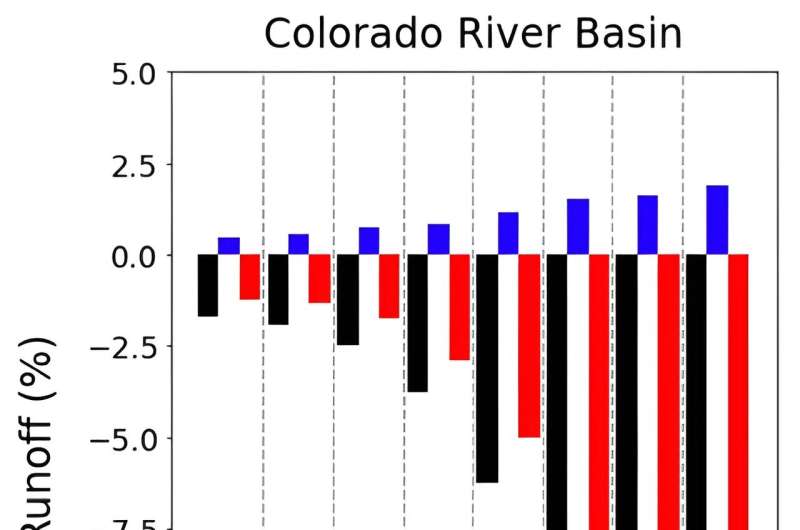July 28, 2023 feature
This article has been reviewed according to Science X's editorial process and policies. Editors have highlighted the following attributes while ensuring the content's credibility:
fact-checked
peer-reviewed publication
trusted source
proofread
Colorado River Basin megadrought caused by massive 86% decline in snowpack runoff

The Colorado River Basin provides freshwater to more than 40 million people within the semi-arid southwestern United States, including major cities such as Las Vegas and Los Angeles. However, between 2000 and 2021 the basin experienced a megadrought (a severe drought lasting multiple decades), which researchers have suggested likely would not have occurred if it were not for anthropogenic climate change. In particular, during 2020 and 2021, the river basin recorded the driest 20-month period since 1895 and the lowest river flow since 1906.
Dr. Benjamin Bass and colleagues at the University of California aimed to identify how precipitation and runoff within the basin have changed since the 1880s, in line with a 1.5°C increase in temperature over the same period. New research, published in Water Resources Research, identified a 10.3% decrease in runoff within the basin as a direct result of anthropogenic warming and vegetation changes in the landscape, meaning available water resources to support the local population have declined 2.1 km3.
Furthermore, the scientists found that snowpack regions were significantly impacted by aridification, exacerbating the decline in runoff to twice that of neighboring areas. Though snowpack regions constitute only 30% of the Colorado River drainage basin, the aridification has led to an 86% decrease in runoff (losing 1.2 km3 of water per °C of warming).
This is likely to worsen due to albedo feedback, whereby the declining snow reduces the lighter "white" snow surface to reflect heat from solar insolation, instead exposing more of the land to absorb heat and ultimately increasing temperature further which causes more snow to melt and so the feedback loop continues.

Using Global Climate Models and historical data, the researchers performed simulations to assess the trends in runoff with anthropogenic changes, as well as predicting the scenarios if human influence is removed. They found that the drainage basin runoff has decreased 1.2 km3 since 1954, but suggest that runoff would have actually increased by 0.9 km3 had the influence of global warming and elevated CO2 not occurred.
Atmospheric carbon dioxide is estimated to have been 285 ppm (parts per million) in 1880, compared to 313 ppm in 1950 and 416 ppm in 2021. It is the influence of increasing CO2 and resulting climate change that show a clear trend in declining runoff, enhancing pace since the 1980s.
Vegetation plays an important part in river basin drainage also by counterbalancing runoff. The researchers describe how elevated CO2 levels cause stomata (pores for gas exchange) on the underside of leaves to close and reduces transpiration (release of water vapor through stomata). However, elevated temperatures lead to increased rates of evaporation from the leaf surface, and this process outweighs any water resource efficiency from transpiration, leading to a net loss of water from the plants. Overall, vegetation does help to offset runoff losses by 15%, though the degree to which this is effective depends upon the type and coverage of vegetation in the basin.
The megadrought since 2000 has experienced a 0.48°C increase in temperature and 3.1% reduction in precipitation than the climate average, while its exacerbation in late 2021 to early 2022 coincided with elevated temperatures of 0.83°C (8.6% higher than the climate mean), plus a 23.9% and 38.6% decrease in precipitation and runoff respectively.
This led to a total decline in runoff for the megadrought of 40.1 km3, and 3 km3 for the recent 2020 to 2021 event, with Arizona, Nevada and Mexico being declared under a water shortage in 2021 and their freshwater allocation was reduced by 0.756 km3. By comparison, this water shortage is greater than the size of Lake Mead in Nevada, the largest reservoir in the U.S. by capacity.
Given the Colorado River Basin's mean annual runoff is 21.2 km3, the loss of ~10% its volume over the last 140 years is significant. As CO2 levels and temperatures are predicted to rise in the future, the rate of water loss could enhance further, posing consequences for the millions who rely upon its waters every day.
More information: Benjamin Bass et al, Aridification of Colorado River Basin's Snowpack Regions Has Driven Water Losses Despite Ameliorating Effects of Vegetation, Water Resources Research (2023). DOI: 10.1029/2022WR033454
Journal information: Water Resources Research
© 2023 Science X Network




















